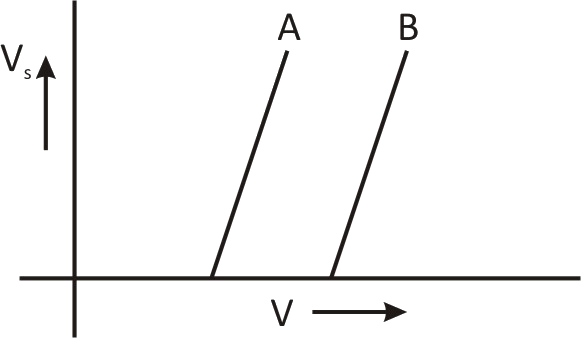
The stopping potential as a function of frequency of the incident radiation is plotted for two different photo electric surfaces A and B. The graphs show the work function of A is:

A. Greater than B
B. Smaller than B
C. Same as that of B
D. No comparison can be done from the given graphs

Answer
552.9k+ views
Hint: First of all, we will observe the graph as given in the question. The horizontal axis represents the frequency of the incident radiation. Frequency is directly proportional to the work function.
Complete step by step answer:
In the given question, we are supplied with the following data:
The graph plot shows the stopping potential versus threshold frequency.
The graph is plotted for two electric surfaces A and B.
We are asked to find out which one of the following conditions is true for the two electric surfaces.
To begin with, we will first go for the Einstein’s equation of photoelectric effect, which is given by:
\[e{V_0} = h\nu - h{\nu _0}\] …… (1)
Where,
\[e\] indicates the charge of the outgoing electron.
\[{V_0}\] indicates the potential of the surface.
\[h\nu \] indicates the energy of the incoming photon particle.
\[h{\nu _0}\] indicates the work function.
We can modify the equation (1) as follows:
$\Rightarrow e{V_0} = h\nu - h{\nu _0}$
$\Rightarrow {V_0} = \dfrac{{h\nu }}{e} - \dfrac{{h{\nu _0}}}{e} \\$
As we can see from the graph is that the threshold frequency for the electric surface A is less than that of electric surface B. It is obvious from the given graph that if we expand the given graph to A and B, the intercept of line A on the \[V - \] axis would be smaller compared to line B, meaning that A's work function is smaller than B's.
So, the correct answer is “Option B”.
Note:
It is important to remember that according to Plank’s quantum theory, light is always emitted from the respective source in the form of discrete packets and these packets of energies are called photons. When the photons hit a surface, the energy of photons is transmitted into the metal surface which excites the electrons present in there. The electrons after gaining the energy move out of the surface.
Complete step by step answer:
In the given question, we are supplied with the following data:
The graph plot shows the stopping potential versus threshold frequency.
The graph is plotted for two electric surfaces A and B.
We are asked to find out which one of the following conditions is true for the two electric surfaces.
To begin with, we will first go for the Einstein’s equation of photoelectric effect, which is given by:
\[e{V_0} = h\nu - h{\nu _0}\] …… (1)
Where,
\[e\] indicates the charge of the outgoing electron.
\[{V_0}\] indicates the potential of the surface.
\[h\nu \] indicates the energy of the incoming photon particle.
\[h{\nu _0}\] indicates the work function.
We can modify the equation (1) as follows:
$\Rightarrow e{V_0} = h\nu - h{\nu _0}$
$\Rightarrow {V_0} = \dfrac{{h\nu }}{e} - \dfrac{{h{\nu _0}}}{e} \\$
As we can see from the graph is that the threshold frequency for the electric surface A is less than that of electric surface B. It is obvious from the given graph that if we expand the given graph to A and B, the intercept of line A on the \[V - \] axis would be smaller compared to line B, meaning that A's work function is smaller than B's.
So, the correct answer is “Option B”.
Note:
It is important to remember that according to Plank’s quantum theory, light is always emitted from the respective source in the form of discrete packets and these packets of energies are called photons. When the photons hit a surface, the energy of photons is transmitted into the metal surface which excites the electrons present in there. The electrons after gaining the energy move out of the surface.
Recently Updated Pages
A man running at a speed 5 ms is viewed in the side class 12 physics CBSE

The number of solutions in x in 02pi for which sqrt class 12 maths CBSE

State and explain Hardy Weinbergs Principle class 12 biology CBSE

Write any two methods of preparation of phenol Give class 12 chemistry CBSE

Which of the following statements is wrong a Amnion class 12 biology CBSE

Differentiate between action potential and resting class 12 biology CBSE

Trending doubts
What are the major means of transport Explain each class 12 social science CBSE

Which are the Top 10 Largest Countries of the World?

Draw a labelled sketch of the human eye class 12 physics CBSE

How much time does it take to bleed after eating p class 12 biology CBSE

Explain sex determination in humans with line diag class 12 biology CBSE

Explain sex determination in humans with the help of class 12 biology CBSE




